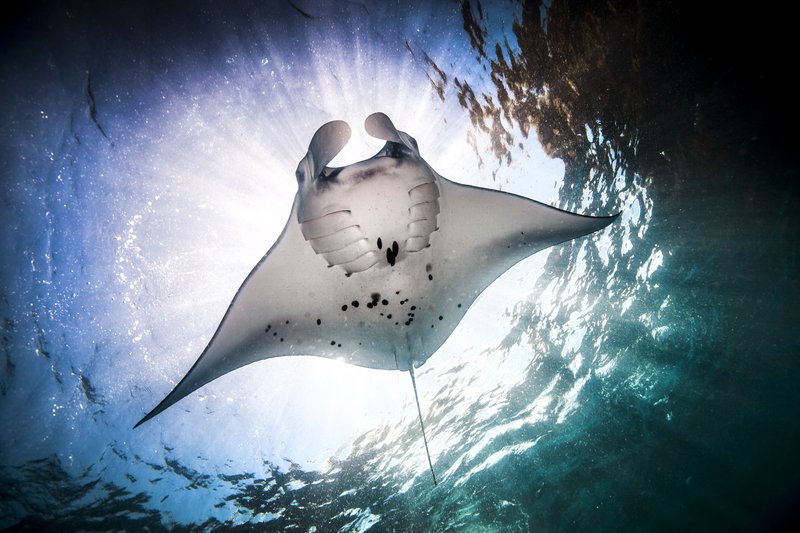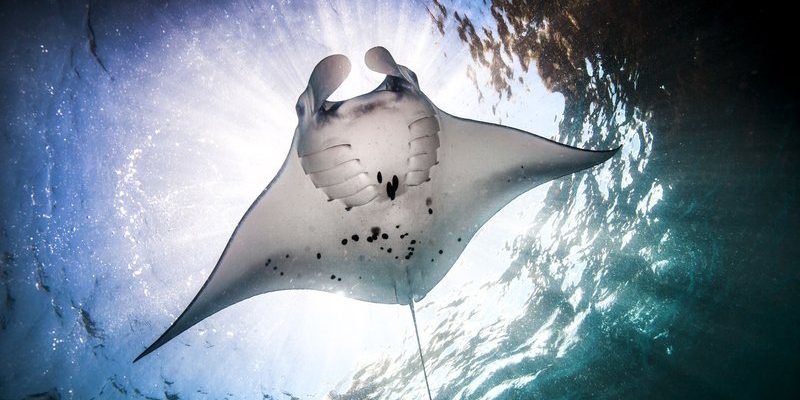
Manta rays belong to the same family as stingrays, but they stand out with their size and unique features. They’re often referred to as the “butterflies of the sea” because of their stunning shapes and patterns. With their flat bodies and enormous fins, they capture the hearts of many marine enthusiasts. Now, you might be wondering what makes them so special. Well, here are ten captivating facts about manta rays that highlight why they’re worth knowing more about.
Manta Rays Are the Largest Rays in the Ocean
You won’t believe how big manta rays can get! The giant oceanic manta ray (Manta birostris) holds the title for the largest ray species, with wingspans reaching up to 29 feet across. That’s roughly the size of a small car! Just picture that for a moment—an enormous animal gliding gracefully through the water, seemingly almost floating.
These gentle giants weigh an astonishing 1,300 pounds or more. Despite their massive size, manta rays are filter feeders, which means they eat tiny organisms like plankton rather than hunting larger fish. They open their mouths wide and scoop up water, filtering out the food as they swim. Honestly, it’s a beautiful sight to witness, seeing such a large animal interact with the ocean in such a peaceful way.
They Have Unique Patterns
Manta rays aren’t just big; they’re also incredibly beautiful. Each manta ray has a unique pattern on their bodies, much like a human fingerprint. These patterns can be used to identify individual rays, which is crucial for researchers studying their behavior and migration patterns. Think of it like having a name tag in the animal kingdom!
These patterns usually consist of light and dark patches along their backs, which can vary greatly from one ray to another. Some might have more spots or different shapes, making each encounter with a manta ray feel special and personal. It’s like meeting a new friend every time you see one.
They Can Leap Out of the Water
Here’s a surprising fact: manta rays can jump out of the water! While it might not be something you’d expect from such large creatures, they can breach the surface, sometimes leaping up to ten feet high. It’s an incredible display of strength and agility, and it’s thought they do this for a few reasons—perhaps to shake off parasites or to show off to other manta rays.
Imagine standing on a boat, watching as a massive ray bursts out of the water like a flying fish. It’s one of those “wow” moments many people cherish during their ocean adventures.
They Are Social Creatures
Unlike many other fish in the ocean, manta rays are known to be quite social. They often swim in groups, and researchers have observed them forming schools of up to 50 individuals. You might find them hanging out together, sharing food, and even playing with each other. Here’s the thing: they seem to enjoy each other’s company, which is pretty remarkable for such large creatures!
These gatherings can also be strategic. Swimming together allows them to locate plentiful feeding grounds more efficiently, as well as gives them safety in numbers from potential threats. They do have some natural predators, such as sharks, but their social behavior provides an extra layer of protection.
Manta Rays Have a Short Lifespan
While it might seem like these amazing creatures have all the time in the world, manta rays actually have a relatively short lifespan. Most manta rays live to be about 20 to 25 years old in the wild. Imagine all the experiences they have during those years—swimming through oceans, interacting with other marine life, and perhaps even exploring coral reefs.
Research shows that many factors can contribute to their lifespan, including environmental conditions and human impact (like fishing and pollution). Conservation efforts are crucial to ensuring that these fascinating creatures can thrive for generations to come.
They Have Specialized Teeth
You might think that with such a large mouth, manta rays would sport some impressive set of teeth. Interestingly, manta rays have tiny, flat teeth that don’t function like typical teeth. Instead, they use these specialized teeth to help them filter out food while feeding. They scoop up water and plankton, using those flat teeth to keep their snacks in check.
Here’s a fun fact: although they do have these small teeth, manta rays don’t use them for biting. They’re not aggressive creatures at all, which is part of what makes them so captivating. Imagine enjoying a meal without having to chew—now that’s a unique dining experience!
They’re Found in Tropical and Subtropical Waters
Manta rays are most commonly found in tropical and subtropical waters across the globe. They love warm ocean temperatures, which is why you’ll often see them near coral reefs or coastal areas. Popular spots for manta viewing include places like the Great Barrier Reef in Australia, the Maldives, and Hawaii. If you ever get the chance to snorkel or dive in these locations, keep an eye out; you might just spot one gliding by!
These creatures prefer clear waters where their food is abundant, allowing them to filter-feed effectively. Their presence in these beautiful locations helps support local ecosystems, emphasizing the importance of protecting their habitats.
They Play a Role in Marine Ecosystems
Speaking of ecosystems, manta rays play a vital role in maintaining the health of marine environments. As filter feeders, they consume massive amounts of plankton and small fish, which helps regulate these populations in the ocean. Think of them as nature’s clean-up crew, keeping the food web balanced.
By filtering out excess plankton, they help ensure that other marine life can thrive. This balance is essential for healthy coral reefs and the overall stability of marine ecosystems. Protecting manta rays isn’t just about their survival; it’s about maintaining the intricate web of life in our oceans.
Conservation Efforts are Crucial
Unfortunately, manta rays face numerous threats, including habitat loss, fishing, and climate change. Their populations are declining in many areas, which is why conservation efforts are so important. Organizations worldwide are working to protect these gentle giants through research, community education, and habitat preservation.
You might be wondering how you can help. Simple actions like supporting sustainable seafood and reducing plastic use can contribute to protecting manta rays and their habitats. Every little bit counts, and by staying informed and advocating for these magnificent creatures, we can work together to ensure their future.
In conclusion, manta rays are genuinely fascinating creatures that deserve our admiration and protection. From their impressive size and unique feeding habits to their social behaviors and critical roles in marine ecosystems, there’s so much more to them than meets the eye. As we continue to learn more about these magnificent animals, let’s commit to conserving their habitats and ensuring they thrive in our oceans for years to come.

